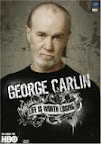No reviews this week.
Wedding anniversay.
Monday, June 30, 2008
Tuesday, June 24, 2008
He liked it when lots of people died

Shit, George Carlin passed away. He was 71 years old and suffered heart failure. In 1972 Carlin released the album Class Clown
Pissed off is how we were used to hearing Carlin’s voice. He was pissed at people for being stupid, for driving SAABs, for not having the brains to change the radio station, and for not thinking for themselves. Much of Carlin’s comedy routines centered on people who were unable to think for themselves or people who allowed others to tell them how to think. American culture, politics and media were his favorite subjects for ranting and raving about.
"Take a fucking chance! Put a little fun in your life! ... most Americans are soft and frightened and unimaginative and they don't realize there's such a thing as dangerous fun, and they certainly don't recognize a good show when they see one."
-Carlin 1999, HBO Special “You are all diseased”
Cunt and Motherfucker are the two words from Carlin’s list that have not made their way onto American television yet. I am sure that a certain cartoon based in a mountain town of Colorado will find a reason to include this word soon enough. Because cable television has different standards for its late night television programs then network TV does.
George, your work taught us to laugh and reminded us to think for ourselves. I know that the world of comedy will not be the same without you, andI will miss your special brand of wisdom.
“There are some people that aren't into all the words. There are some people who would have you not use certain words. Yeah, there are 400,000 words in the English language, and there are seven of them that you can't say on television. What a ratio that is. 399,993 to seven. They must really be bad. They'd have to be outrageous, to be separated from a group that large. All of you over here, you seven. Bad words. That's what they told us they were, remember? 'That's a bad word.' 'Awwww.' There are no bad words. Bad thoughts. Bad Intentions.”
-Carlin 1972, 7 Words you can’t say on television
Monday, June 16, 2008
Starman Omnibus Volume 1

In 1994 a once great, albeit obscure super hero from World War II passed along his legacy to his son David, much to the delight of his other son Jack who wanted nothing to do with “that ridiculous costume”. Before David or Jack knew what was happening, David had been murdered by the son of his father’s arch enemy The Mist, and Jack was fighting for his life. When The Mist threatened his father Jack stood his ground and the light of Starman lit the skies over Opal City once more.
Starman is a tale of nostalgia and family that broke fresh ground for DC Comics, turning stories in a new direction that would change the literary fate of Superman, Batman, and the entire stable of capes and costumes. Jack Knight is a poster child for Generation X sporting tattoos, a rebellious streak, and wearing a black leather jacket instead of a costume.
Writer James Robinson and artist Tony Harris created a character and a city who are one in the same. Opal City is a city of art deco rooftops, hidden treasures in back alleys, and dark secrets hidden for decades. Jack Knight is a mixture of antique dealing curiosities, and hidden depths of maturity buried under snide comments.
Robinson always wondered what Super Heroes talked about when they were working together. Did they talk about music, or movies, or maybe even a recent purchase of carpeting for their secret lair? Robinson set out to write a super hero story that made sense to him. He wanted to create a hero that you could run into in a coffee shop and talk about the weather with. To Robinson, it did not make sense for someone like Jack to run around in spandex like his father did. Jack admires the work his father did and when the family business is thrust upon him, he follows in the steps of Sinatra. He did it, his way.
Starman was a turning point for DC comics, Jack debuted in the 90’s during an era of comics when foil covers and alternative printings saturated the shelves. While one universe was facing a plague to end all mutant life, another was having time rewritten by a hero gone mad. Comic fans barely noticed a young man in a bowling shirt and leather jacket quietly sneak onto the stands. Jack brought with him a great weapon, nostalgia. Jacks’ pithy quips and commentary on Cole Porter, Woody Allen films and James Cagney surprised many readers. In an age of large caliber firearms and the strength to move planets Jack reminded readers that heroes worry about being on time to dinner with their father, or if he would survive this battle with Shakedown so that he could put a final bid in on a collection of Fenton glassware. Jack brought an edge of reluctant maturity to comic books, reminding the adults who grew up reading Spiderman that they could still find a hero to relate to.
Starman Omnibus Volume 1 presents the series in the order that it was released in, unlike DC comics’ previous collection of the series. Robinson wrote the entire run on Starman, and occasionally included issues set in different eras. Stand alone stories of other heroes who bore the name Starman. DC Comics collected all of these “Times Past” stories in a single volume, removing them from the order Robinson had originally intended them to be released in, obscuring the relevancy of their stories to the overall story arc. Also, much like a DVD directors commentary track Robinson has included his notes to the series, including his thoughts and influences on writing the series.
In this modern era of obscure plotlines from the 1970’s returning to threaten the heroes of today, it seems fitting that Jack Knight and his obscure commentary return. Once again the skies of Opal City are lit by Starman.
Labels:
2008,
Comic Books
Monday, June 2, 2008
Man of Tomorrow, Movie of Yesterday

Superman II - The Richard Donner Cut
In 1978 audiences were shown a side of Superman they’d never seen before, a Superman who made us believe that a man could fly. In 1981 Warner Brothers tried to make magic strike twice, but what they showed us was not the original vision of the man of steel.
In an unprecedented move, Warner Brothers hired Richard Donner to film two movies at the same time. A move we would not see again until 2002 when Peter Jackson released The Fellowship of the Ring,
Richard Donner had shot enough footage for a second film already; Warner Brothers spent more money shooting a new script under the helm of Richard Lester. Superman II
If Firefly
Donner’s film showed an extremely different version of our main characters. He gave us a Superman more Kansas then Krypton, and a Lane more obsessed with discovering Superman’s identity then with the consequences of her actions. Donner’s villains were given more screen time, and his supporting characters were shown as something more than a caricature. Most importantly, Donner’s edit of the film holds its own alongside more modern films such as Batman Begins
This movie is proof that comic books can be made into strong movies showing adult themes and adult level relationships. If Warner Brothers had released this movie in 1981, would we have been subjected to cinematic garbage such as Catwoman, Steel, or LXG?
Subscribe to:
Posts (Atom)
